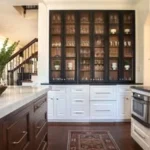Cabinetry Glossary of Terms
Sometimes when us "designery" peeps get on a roll we start to throw words at you that we assume you know, like “pull" or "plate” or "finger route.” Then we might see this very confused look on your face. We hope this section of our kitchen cabinet guide will assist you in knowing what we mean when we ask questions like, “Would you like a catch latch on that inset cabinet door?”
- Appliance Garage - Used to keep items off the countertops, an appliance garage is a cabinet that is positioned underneath a wall cabinet and equipped with a flexible, sliding door or shutter that looks like a garage door. (aka tambour door, or appliance door)
- Appliance End Panels - Used to give the appliance the look of furniture or built-ins this 1 ½” – 3” stile (filler) is typically positioned next to dishwashers or refrigerators.
- Back Plate - Sometimes called escutcheons, a back plate is the circular or curved plate (traditionally brass) that sits between the handle, pull, knob and the face of the cabinet drawer or door.
- Base Cabinet - the cabinet box that sits on the floor. These cabinets support the countertops. Also referred to as “lower cabinets”.
- Beadboard - Wood paneling that contains vertical parallel grooves to give the cabinet added style and texture
- Butt Doors – Door on a double door cabinet that when closed, nearly touch each other. Typically, a 1/8" gap is allowed between the butt doors.
- Catch Latch (Door Catch) - A catch is a mechanism that "catches" the door as it closes and prevents the door from opening on its own.
- Corbel - A decorative bracket that can be used as a support piece for mantels, shelves, countertops and more.
- Center Stile - Usually found on wider than normal cabinets, these vertical strips of wood divide cabinets for extra support and stability.
- Concealed Hinge - A hinge attached to the inside surface of the door, so that it is not visible when viewing the front of a cabinet door.
- Crown Molding - In general, this is any molding applied to the top of wall cabinets to provide a decorative, finished look.
- Decorative Doors / Dummy Doors - False doors with the same styling as the working cabinet doors that are installed on the side of end cabinets or on the back of an island or peninsula cabinet.
- Dishwasher Panel - A finished panel used to cover the exposed side of a dishwasher. This panel looks like the finished side of a cabinet and provides support for the countertop.
- Dovetail Joint - Woodworking joints known for their strength and durability that connect drawer sides to the drawer face without hardware. The two joint ends are cut into a series of angled pieces that look like dovetails and interlock with one another making them very difficult to separate.
- End Panels - The sides of the cabinet that are attached to the face frame and extend back to the wall.
- Exposed Hinge - a hinge type that is visible on the outside edge of the cabinet door when the door is closed.
- Extend end stile down - This extends the side stile down to the floor. Typically around appliances or to end a run of cabinets. This is most commonly found in higher end designs and is limited to semi-custom and custom cabinet lines.
- Extended Stile - Same concept as a Filler, except it is an extension of the cabinet stile, and offers a more custom look. Typically only available from semi-custom and custom manufacturers
- Face Frame - The structural portion of the cabinet that helps to provide stability to the cabinet. The face frame attaches to the top, bottom, and sides of the box. This is also where the door gets hinged to the cabinet.
- Fillers - Pieces of hardwood matching a chosen cabinet color. Common use is to fill the space where a modular cabinet does not fill a specific wall dimension.
- Finger Route - A reveal cut into the top of a cabinet door or drawer for opening and closing
- Flip-up Door – A cabinet door designed to function by flipping up, hinging up, or a vertical lift up.
- Framed Cabinet - A cabinet design that uses a 'face-frame' for the construction of the front of the cabinet box, where the door gets hinged.
- Frameless Cabinet - Also referred to as Eurostyle, this cabinet design does not use a frame on the front edges of the cabinet box. Instead, the front of the cabinet box consists of the front edges of the top, bottom and side panels of the cabinet box and is covered by the cabinet door when closed.
- Full Overlay - In this cabinet design, the cabinet door or drawer front covers the entire face frame of the cabinet. A cabinet is considered full-overlay when the reveal is less than ¼ inch.
- Inset Cabinet - In this cabinet design, the cabinet doors fit inside of the face frame when closed as opposed to sitting on top of the face frame.
- Lead Time - This is an approximation of how long it will take to get your materials. It could be 8 weeks or 8 days, but it is always considered approximate (or “prox” as we fondly call it!). Some of the variables that affect lead team are processing time, transit time, backorders by manufacturers and the like. Lead times are especially helpful to know when planning the timing for your project.
- Light Rail Molding - Molding placed underneath cabinets for decoration or to cover under-cabinet light fixtures.
- MDF - Medium Density Fiberboard - is a man made wood product created by breaking down wood residuals into wood fibers which are then exposed to heat and pressure to form the fiberboard.
- MDF End – (aka furniture end) a cabinet construction term referring to the cabinet end panels being constructed from MDF or furniture board. To achieve a finished end either a laminate veneer or a thin plywood veneer is applied.
- Mullion - Mullions are glass window dividers inside cabinet doors that provide support in addition to decoration.
- Oven Cabinet - A tall cabinet for built-in ovens that houses single or double ovens or a combination of a microwave and oven.
- Overlay - Overlay is a cabinetry term that refers to the amount of face frame covered by the cabinet door or drawer front.
- Partial Overlay/Half Overlay - In this cabinet design the cabinet door or drawer front only partially overlaps the face frame when closed and more than ¼ inch of the face frame remains visible.
- Plywood - wood veneer that is connected by adhesive forming panels of a variety of thicknesses.
- Plywood End – a cabinet construction term referring to the cabinet end panels being constructed out of plywood instead of furniture board or MDF. This is typically an upgrade or found in higher-end cabinetry lines.
- Pocket Door – hinged cabinet doors that swing open and slide back into the side of your cabinet to offer full access to and unobstructed views of the area inside the cabinet.
- Pulls - otherwise known as a handle is attached to the cabinet door or drawer front utilizing two or more screws. The center-to-center measurement (the distance from the center of one screw hole to the center of the next) is the most important factor in determining handle choice.
- Quarter Round Molding - A molding positioned between cabinets and flooring to conceal gaps. For smaller gaps, a scribe molding may be employed.
- Rail - The horizontal members of a cabinet's face frame or door frame.
- Raised Panel - A cabinet door style that has a slightly raised center panels.
- Recessed Panel – A cabinet door style that has a center panel that is inset or recessed. (ie. Shaker door)
- Reveal - The exposed portion of a cabinet face frame that is not covered by the cabinet door.
- Roll Out Tray - A favorite cabinet feature installed in base cabinets or pantries as a replacement for fixed shelving. The trays attach to the cabinet sides with drawer glide hardware so they can extend beyond the cabinet frame providing easier access to its contents.
- Shaker Style – A popular cabinet door style that has a simple recessed panel design.
- Slab Front - A flat door panel with no design, moldings, recessed or raised areas. Commonly used to give a more contemporary appearance.
- Soft-Close Drawers/Doors - Also known as self-closing, this cabinetry contains hardware with a mechanism to slowly and safely close a cabinet drawer or door even when slammed shut.
- Stile - The vertical members of a cabinet's face frame or door frame.
- Toe kick - Recessed several inches from the front surface of the base cabinet, the toe kick allows space for a person's feet when standing in front of the cabinet so their body can be closer to the cabinet than otherwise possible.
- Undermount Glides - A higher-end type of drawer glide hardware which is mounted underneath the drawer, as opposed to the sides of the drawer. Undermount guides can usually carry more weight than side mount guides.
- Wainscot - A wooden facing or paneling applied to a wall, island, end panel, or exposed sides of a cabinet to provide a more finished look.
- Wall cabinet - Cabinet boxes that are mounted to the wall. Also referred to as “upper cabinets.”
- Work Triangle - A design concept developed in the 1920's based on the ergonomics of kitchen layouts. Kitchen designers use the work triangle as an aid in remodeling a kitchen based on three main work areas of the sink, the refrigerator and the stove/oven. For more information check out our kitchen work triangle blog article.



